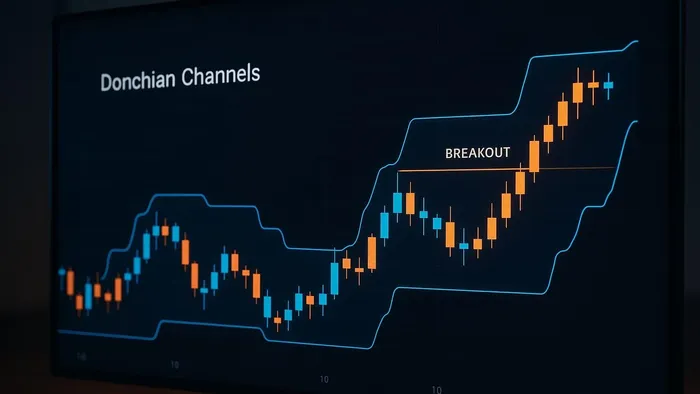Learn how to leverage Donchian Channels for breakout and trend-following strategies to enhance your trading performance and manage risk effectively.
Donchian Channels are a simple yet effective tool for identifying breakouts, tracking trends, and assessing market volatility. They consist of three lines:
- Upper Band: Highest price over a set period.
- Lower Band: Lowest price over the same period.
- Middle Line: The average of the upper and lower bands.
Key takeaways:
- Breakouts above the upper band signal bullish momentum; drops below the lower band indicate bearish pressure.
- The channel's width reflects market volatility — wider bands mean higher volatility, while narrower bands suggest consolidation. For a primer on the concept, see this overview of Donchian Channels and how they work.
- The middle line acts as a dynamic support or resistance level in trending markets.
How to Use Donchian Channels:
- Breakout Strategy: Enter long when price breaks above the upper band; go short when it drops below the lower band. Confirm with volume or additional filters to reduce false signals.
- Trend-Following: Trade pullbacks to the middle line during strong trends. In uptrends, price often stays above the middle line; in downtrends, it remains below.
- Volatility Analysis: Narrowing channels often precede breakouts, while expanding channels indicate strong momentum.
For traders, setting the right period length (e.g., 20, 55, or 100) depends on your trading style — shorter periods for day trading, longer for swing or position trading.
Risk Management Tips:
- Place stop-losses near the opposite band or middle line.
- Limit risk to 1–2% of your account per trade.
- Use volume analysis and trailing stops to improve trade outcomes.
LuxAlgo provides advanced resources on TradingView and other platforms that enhance Donchian-channel strategies with better signal confirmation, backtesting, and market scanning. This combination helps refine entries, exits, and overall strategy execution.
How to Use Donchian Channels for Trading
Setting Up and Reading Donchian Channels
Adding Donchian Channels to your chart is straightforward, but understanding their signals is where the real value lies. Let’s go over the setup process and explore the key signals you should pay attention to.
How to Add Donchian Channels to Your Chart
Getting Donchian Channels up and running on TradingView is quick and easy. Start by opening your chart and clicking the "Indicators" button at the top. In the search bar, type "Donchian", and the indicator will pop up in the results. Select it, and it’ll be added to your chart.
Once applied, you’ll notice three lines: the upper band, lower band, and a middle line. The default period is usually 20, but you can tweak this by clicking the gear icon next to the indicator name in the left panel. From there, you can adjust the period length and even customize the visual style.
Many traders find it helpful to enable a semi-transparent fill between the upper and lower bands to make the channel more noticeable. To do this, go into the style settings, check the "Background" option, and set the transparency to around 85–90%. You can also adjust the line thickness and colors for better clarity.
Once your channels are set up, the next step is to interpret what they’re telling you about the market.

Reading Donchian Channel Signals
With the Donchian Channels on your chart, the positioning of price relative to the bands becomes a powerful tool for understanding market sentiment.
- Breakouts: When the price moves above the upper band, it suggests bullish momentum. Conversely, a drop below the lower band indicates bearish pressure.
- Volatility: The width of the channels reflects market volatility. Wider bands mean higher volatility, while narrower bands suggest the market is consolidating.
The middle line also offers valuable insights. In trending markets, price often stays on one side of the middle line for extended periods. For example:
- During an uptrend, the price generally stays above the middle line, using it as a dynamic support level.
- In a downtrend, the price tends to remain below the middle line, where it acts as dynamic resistance.
Another key pattern to watch for is the squeeze, where the channel narrows significantly. This indicates low volatility and often signals that a big move could be on the horizon. Traders use these moments to prepare for potential breakouts.

Selecting the Right Period Length
The period length you choose for your Donchian Channels depends on your trading style and the timeframe you’re analyzing. This setting determines how many bars the indicator considers to calculate the highest high and lowest low.
- Day traders often use shorter periods, like 10–20, to capture quick market moves. These settings are more sensitive but can produce more false signals.
- Swing traders tend to prefer periods between 20 and 55, which help filter out noise while still capturing meaningful price action.
- Position traders and those focusing on long-term trends might use periods of 55 to 100 or more. On weekly charts, these settings smooth out short-term fluctuations and highlight major trend shifts but generate fewer signals.
The classic 20-period setting, introduced by Richard Donchian, is a popular choice because it balances responsiveness with reliability. It works well across many timeframes, providing a solid starting point.
To refine your approach, consider experimenting with different period lengths on historical data. You can even use multiple timeframes with varying settings to get a broader perspective on market conditions. This way, you’ll align your Donchian Channels with your trading strategy and risk tolerance.
Breakout Trading with Donchian Channels
Breakout trading with Donchian Channels highlights moments of momentum when prices push beyond their boundaries. But to make this strategy work, you need to master the timing, confirm the signals, and manage your risk effectively.
How to Trade Breakouts with Donchian Channels
The basic idea is straightforward: go long when the price closes above the upper band, and go short when it closes below the lower band. This approach aims to catch momentum as it builds, allowing you to ride meaningful price moves.
For bullish breakouts, wait for a candlestick to close above the upper Donchian Channel. The signal becomes stronger if this is paired with a noticeable increase in volume, suggesting genuine buying interest rather than a fleeting spike.
Bearish breakouts follow the opposite logic. A close below the lower band signals that sellers have taken control, pushing prices to new lows within the lookback period. This often marks the start of a downward trend, especially in previously consolidating markets.
You can either enter the trade at the close of the breakout or wait for a pullback to the breakout level, which can improve the risk-reward ratio.
Using multiple timeframes can also refine your timing. For example, a breakout on a daily chart carries more weight if the same signal appears on a weekly chart. This alignment increases the likelihood of a sustained move while filtering out weaker signals.
Breakouts tend to be more explosive after a period of consolidation, where the Donchian Channels narrow. These tight ranges often signal pent-up energy that gets released in a strong directional move.
For additional confirmation, some traders cross-check momentum using the Relative Strength Index (RSI). Look for momentum to rise as price breaks the band, not fade.
Once you’ve nailed your entry, the next step is managing your risk during the often-volatile breakout phase.
Risk Management for Breakout Trades
What separates successful breakout traders from the rest is how they handle risk. Proper stop placement and position sizing are essential to weather the inevitable false signals and capitalize on the real moves.
For stop-loss placement, consider the opposite Donchian Channel band. For long trades, place the stop just below the lower band; for shorts, position it slightly above the upper band. This gives your trade room to breathe while ensuring a clear exit if the breakout fails.
Another option is to use the middle line of the Donchian Channel as a dynamic support or resistance level. In strong trends, prices often respect this level, making it a logical place to exit if momentum starts to fade. While this method may result in smaller losses, it could also stop you out of trades that eventually recover.
To keep your risk consistent, limit it to 1–2% of your account per trade. Adjust your position size based on the distance to your stop-loss — wider stops mean smaller positions.
Protect yourself from false breakouts by adding filters, such as confirming the move over two periods or requiring a set percentage increase or decrease. While this reduces the number of trades, it can improve your success rate.
Volume analysis is another useful tool. True breakouts often occur on higher-than-average volume, while false ones tend to happen on lighter volume. If the volume doesn’t back up the price move, it might be worth waiting for more confirmation or skipping the trade altogether.
Once in a trade, consider scaling out by taking partial profits at key levels or after reaching a 2:1 risk-reward ratio. For the remaining position, use trailing stops to lock in gains as the trend progresses.
Breakout Strategy Pros and Cons
Like any trading approach, breakout strategies with Donchian Channels have their strengths and weaknesses. Understanding these can help you set realistic expectations and refine your approach.
| Advantages | Disadvantages |
|---|---|
| Clear entry signals — Provides mechanical, objective entry points, removing guesswork | False breakouts — Markets often test channel boundaries without follow-through, leading to losses |
| Captures momentum — Positions you early in trends to maximize profit potential | Whipsaw markets — Sideways conditions can trigger multiple false signals, eroding capital |
| Easy to apply — Simple rules make it accessible for traders of all levels | Late entries — Breakouts often occur after significant moves, limiting profit potential |
| Works on multiple timeframes — Can be applied to intraday, daily, or weekly charts | Discipline required — Success depends on consistent execution and accepting small losses |
| Trend-following approach — Aligns with the market’s natural tendency to trend over time | Lower win rate — Many breakout attempts fail, so larger winners are needed to offset frequent small losses |
The strategy tends to shine in trending markets, where momentum continues after the breakout. During these periods, the advantages far outweigh the drawbacks, and traders can capture substantial moves.
On the flip side, range-bound markets can be tricky. In these conditions, false signals are more common, making it harder to achieve consistent success. To adapt, consider reducing your position size, applying stricter filters, or stepping back until clearer trends emerge.
Trend-Following with Donchian Channels
Trend-following strategies aim to keep you in the market during strong, established trends, maximizing potential profits. Using Donchian Channels, traders can identify and ride these trends effectively. While this approach demands patience and discipline, it can lead to highly rewarding trades when executed well.
Spotting Trends with Donchian Channels
Donchian Channels help traders identify trends by showing how price interacts with the channel's bands. The price's position relative to these bands provides key insights into the market's direction.
In an uptrend, the price often stays near or above the upper band for extended periods. You'll notice a pattern where the price touches the upper band, pulls back slightly, and then pushes to new highs — forming a series of higher highs and higher lows. This is the hallmark of a strong uptrend.
For downtrends, the behavior is reversed. The price gravitates toward the lower band, creating a sequence of lower highs and lower lows. Bounces off the lower band often present opportunities for short trades as the downward momentum continues.
The middle line of the channel acts as a momentum checkpoint. In strong uptrends, the price rarely dips below this midpoint, and if it does, it quickly rebounds toward the upper band. Conversely, in downtrends, the price struggles to rise above the middle line, and any rallies tend to be short-lived.
The width of the channel also reveals trend strength. Wider channels indicate high volatility and strong momentum, while narrowing channels suggest a weakening trend. Sustained trends often maintain consistent channel width, signaling steady momentum.
Pay close attention to how the price behaves near the bands. Genuine trends rarely linger in the middle of the channel. Instead, in uptrends, the price oscillates between the upper band and the middle line, while in downtrends, it moves between the lower band and the middle line. These patterns set the stage for strategic entries during pullbacks.
Entering Trades on Pullbacks
One of the keys to successful trend-following is entering trades during pullbacks rather than chasing price extremes. This approach helps improve your risk-reward ratio while keeping you aligned with the overall trend.
For long entries in an uptrend, watch for the price to pull back toward the middle line of the Donchian Channel. This level often acts as dynamic support, offering a chance to enter at a better price. The ideal scenario occurs when the price touches or slightly dips below the middle line and then shows signs of bouncing back toward the upper band.
Short entries in a downtrend work similarly. Look for rallies that approach the middle line but fail to break above it. These failed rallies often mark excellent opportunities to enter short positions and continue riding the downward trend.
Another approach involves using the opposite band as a guide. In strong uptrends, a drop toward the lower band might signal an oversold condition and a potential buying opportunity. However, caution is necessary — if the price decisively breaks below the lower band, it could indicate a trend reversal rather than a pullback.
Timing is everything when trading pullbacks. Instead of entering immediately when the price reaches your target level, wait for confirmation that the pullback is ending. This confirmation could come through a bullish candlestick pattern, increased volume during the bounce, or price action suggesting buyers or sellers are stepping back in.
In strong trends, pullbacks are typically brief, lasting a few days to a week. If a pullback drags on longer, it might signal that the trend is weakening or transitioning into a sideways market.
Volume analysis can further refine your entries. During a pullback, declining volume followed by a surge as the price resumes its trend suggests the pullback was a pause rather than a reversal.
Using Volatility to Predict Trend Changes
Volatility patterns within Donchian Channels can provide early warnings of trend changes, helping you adjust positions or prepare for new opportunities.
Contracting channels often signal the buildup of potential energy for a significant move. When the distance between the upper and lower bands narrows over several periods, it indicates reduced volatility and often marks the end of a current trend. This contraction phase can lead to either a reversal or a period of consolidation.
Expanding channels indicate rising volatility and momentum. In trending markets, expansion usually aligns with the trend's direction, reinforcing its strength. However, dramatic expansion after a prolonged trend might suggest exhaustion — a final push before a reversal.
Look for volatility divergences between price and channel width. If the price reaches new highs but the channel width contracts or remains unchanged, it could signal weakening momentum. Such divergences often precede trend reversals by weeks or months, giving you time to adjust your strategy.
The rate of channel expansion also matters. Gradual expansion indicates sustainable momentum, while sudden, sharp expansion often points to unsustainable moves that are prone to quick reversals.
Breakout volatility can offer clues about trend reliability. When the price breaks out of a contracting channel with high volatility, the resulting trend is often more reliable and long-lasting. On the other hand, breakouts on low volatility are less likely to sustain momentum.
Consider the historical context of the current channel width. If the channel width approaches historical extremes for the asset, it might indicate an unsustainable condition. Markets tend to revert to average volatility levels over time, which can help you anticipate when trends might lose steam.
Finally, observe how the price behaves during volatility spikes. In strong trends, temporary increases in volatility should resolve in favor of the trend. If volatility spikes consistently lead to moves against the trend, it may be time to reassess your position or tighten your stop-loss levels.
Improving Donchian Channel Strategies with LuxAlgo Tools

Donchian Channels are a reliable foundation for breakout and trend-following strategies, but pairing them with exclusive tools can take your trading to the next level. LuxAlgo provides indicators and AI-driven features that work seamlessly with Donchian analysis, helping you fine-tune entries, improve risk management, and identify higher-probability setups. By integrating these resources, you can refine your trading approach and make more informed decisions.
Adding LuxAlgo Tools to Donchian Channel Strategies
Three major categories — Price Action Concepts (PAC), Signals & Overlays (S&O), and Oscillator Matrix (OSC) — add layers of analysis that pair well with channels:
- Price Action Concepts (PAC): Tracks market structure changes that align with Donchian Channel breakouts. Volumetric order blocks can highlight institutional activity.
- Signals & Overlays (S&O): Useful for timing entries during pullbacks near channel bands (e.g., using Opening Range with Breakouts & Targets).
- Oscillator Matrix (OSC): Momentum analysis with real-time divergence detection that can warn when momentum weakens at channel extremes.
For instance, imagine a stock breaking above its Donchian upper band while PAC identifies a bullish structure shift. This combination suggests institutional support for the move, helping you avoid false breakouts that lack volume confirmation.
The LuxAlgo Universal Conditions Identifier (LUCID) ties these categories together, allowing AI workflows to combine data from PAC, S&O, and OSC for deeper insights. Each category also includes screeners, enabling you to scan markets for assets that meet your preferred Donchian setups.
Testing Strategies with the AI Backtesting Assistant
LuxAlgo’s AI Backtesting Assistant simplifies strategy testing, making it accessible even if you lack programming skills. It walks you through the testing process and helps you interpret performance metrics — enabling tests that blend Donchian Channels with multiple LuxAlgo indicators.
The platform evaluates strategies across various tickers and timeframes simultaneously. For example, you might discover that a breakout strategy works well on technology stocks during four-hour timeframes but performs poorly on other asset classes. These insights allow you to adjust your approach accordingly.
Additionally, the AI can optimize parameters like Donchian period lengths and stop-loss levels for specific market conditions. Once tested, the platform even provides code for deploying strategies on TradingView.
Learning from the LuxAlgo Community
LuxAlgo’s community offers a wealth of knowledge to help you refine Donchian Channel strategies. Traders share practical approaches for combining Donchian Channels with other technical methods, including custom alert setups that integrate Donchian signals with LuxAlgo conditions.
Subscribers to the Ultimate plan gain access to additional resources like weekly scanners and backtests that highlight emerging trends or sector rotations, while 24/7 support helps with implementation details.
Conclusion
Donchian Channels offer a simple yet effective way to approach breakout and trend-following strategies. By tracking the highest highs and lowest lows, they help traders identify critical levels for potential price movements. The concept is straightforward: go long when the price breaks above the upper band, or short when it drops below the lower band — making the indicator approachable for traders at any skill level.
The key lies in understanding when to use each strategy. Breakout strategies shine in markets poised to start new trends, while trend-following techniques excel in capturing ongoing momentum. This flexibility allows traders to adapt as market conditions shift.
To take your trading further, LuxAlgo provides visual indicators, backtesting support, and screeners that simplify testing and fine-tune trading signals. These resources complement Donchian Channels, creating a more comprehensive trading approach.
FAQs
What is the best period length to use for Donchian Channels based on my trading style?
The best period length for Donchian Channels largely depends on your trading approach and the market conditions you’re navigating. Many traders prefer a 20-day period since it mirrors a typical trading month and is effective for spotting medium-term trends.
For those engaged in short-term or intraday trading, opting for a shorter period, like 10–14 days, can generate more frequent signals. However, keep in mind that this may also increase the likelihood of false breakouts. On the other hand, if you’re into long-term position trading, using a longer period, such as 30–55 days, can help you identify more sustained trends over extended periods.
When choosing the right period, think about your trading objectives, the asset’s volatility, and how much risk you’re comfortable taking on. Experimenting with and fine-tuning the settings based on your strategy can enhance the indicator’s effectiveness.
How can I confirm breakout signals when using the Donchian Channels indicator?
To validate breakout signals using the Donchian Channels indicator, start by checking for a price candle that closes distinctly above the upper band (for bullish breakouts) or below the lower band (for bearish breakouts). This clear closure helps confirm the breakout's legitimacy.
Next, incorporate volume analysis to see if there's a noticeable increase in trading activity. A spike in volume often reinforces the credibility of a breakout. You can also use momentum indicators like the RSI to assess whether the trend is picking up strength.
By combining these techniques, you can better filter out false alarms and approach your trading decisions with greater confidence.
How can I use LuxAlgo tools with Donchian Channels to improve my trading strategy?
Pair LuxAlgo’s Donchian MA Bands with complementary indicators like Opening Range with Breakouts & Targets and Triangular Momentum Oscillator (with divergences) for confirmation. For structure-based stops and trend control, use Market Structure Trailing Stop. These combinations can make entries/exits more reliable while improving risk management.
References
LuxAlgo Resources
- Donchian MA Bands
- Market Sentiment Technicals
- Breakout Detector (Previous MTF High Low Levels)
- Pullback Trading vs. Trend Reversals
- Backtesters: Take-Profit & Stop-Loss (S&O)
- Volumetric Toolkit
- Market Structure Trailing Stop
- Breakouts with Tests & Retests
- Swing Breakout Sequence
- PAC: Market Structures
- PAC: Volumetric Order Blocks
- Opening Range with Breakouts & Targets
- Triangular Momentum Oscillator (Real-Time Divergences)
- AI Backtesting Assistant
- Alert Scripting Update: Actions








